ConnectWell® at the Library
Report released September 1, 2025
Full report name: ConnectWell® at the Library Report: Piloting 5-Week Wellness Challenge Model at Public Libraries to Evaluate the Public Library as Venues for Learning about and Adopting Healthy Lifestyle Practices
By Andrea Bloom & Noah Lenstra
Report Summary
Introduction: How ConnectWell Came to Serve Public Libraries
ConnectWell at the Library Supports the Adoption of Healthy Lifestyle Practices
Description of the Pilot
Facilitator Survey Results and Testimonials
Library Challenge Activities
Diving into the Data
Participant Survey Results
Learn More
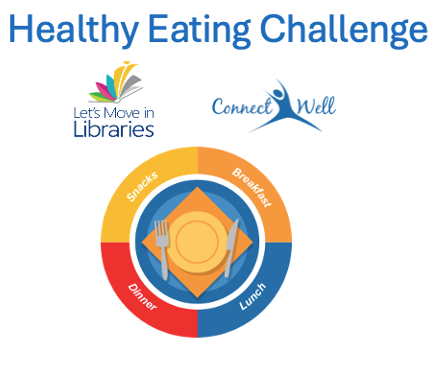 Report Summary
Report Summary
This report includes the results of a project that took place in the first 6 months of 2025 from January through June facilitated with Let’s Move in Libraries. Twelve rural and suburban libraries from across the country participated in this cohort that deployed ConnectWell’s 5-week Balance Well Healthy Eating Challenge at their libraries. Overall we found that the Balance Well Healthy Eating Challenge developed by ConnectWell supports:
- Increasing nutrition knowledge
- Changing eating habits for the better (measured across 19 metrics)
- Continuing with new-found healthy eating practices post challenge
- Desire to participate in another ConnectWell Challenge
These results are very promising given that 70% of preventable illness is due to unhealthy lifestyle habits. Learning in community at the library using ConnectWell’s Wellness Challenge Model (Learn, Take Action, Support) shows promise that the library can be a significant community partner for improving public health related to lifestyle. The pilot demonstrated the deep learning that took place, both at the library and at home in between sessions, by accessing ConnectWell’s digital resources. Participants took action by changing their eating habits across many factors. Adopting healthy eating practices is the start of reversing food-related illnesses (metabolic syndrome, prediabetes, obesity, diabetes) that impact the majority of Americans of all ages. Participants found support in the library community and a positive experience delivered by the challenge facilitators with ConnectWell’s comprehensive challenge materials. We look forward to your reviewing the report and learning about ConnectWell’s Challenge Model for 18 Wellness Challenges that support lifestyle change at libraries to improve health and unlock vitality. Please share the report widely with your colleagues.
Introduction: How ConnectWell came to Serve Public Libraries
ConnectWell was founded in 2010 to deliver an innovative wellness offering that combines proven science and practical methods to prevent and reverse chronic diseases related to lifestyle. ConnectWell started out by delivering wellness programs at workplaces. These workplace wellness programs were very well received and were delivered in group format at worksites. One multinational organization found the programs to be so well received by US worksite locations that they had the programs translated into 8 languages and deployed them across the company’s geographic locations. As the healthcare industry embraced technology, ConnectWell evolved its offering to include a comprehensive digital health & wellness information resource designed for a consumer audience to engage people in their health and well-being. In 2023 ConnectWell began serving public libraries at the request of library professionals. ConnectWell embraced the opportunity to serve libraries as it fits with the company’s vision: ConnectWell empowers people to make informed health decisions and improve well-being by scaling health literacy through democratizing access to digital health and wellness content that is science-based and designed for a wide-ranging consumer audience.
Public librarians found the ConnectWell Health & Wellness Database to be better for their patrons in comparison to standard database products that are designed for researchers. Standard databases have multiple drawbacks including and not limited to: a high reading level, an overwhelming amount of information, long and complex articles from peer-reviewed journals, and outdated health information by including articles back to the 1990s. Standard databases make it hard for a non-researcher, the typical public library patron, to sort through database listings and decide what is relevant for the health condition they are researching. In contrast, ConnectWell’s content is crafted with the end user in mind and is kept up-to-date and includes these features:
- Complex medical information and care guidelines are transformed into easy-to-understand segments in text and video format
- Information sourced from the most trusted health institutions provides the latest standard-of-care guidelines and scientific findings on health, wellness, disease management, and nutrition
- Incorporates Mayo Clinic’s Health Information to access its world-renowned content that integrates into the platform
- Written for a wide audience with multi-language capability, and full of engaging language and visuals
- Keywords that enable end users to easily search for information based on their health conditions, health goals, and food preferences
- Wellness Initiatives that provide a holistic approach to the adoption of healthy lifestyle practices
- Videos from Mayo Clinic and University of California experts
- A healthy recipe collection that promotes better living through healthier eating
Furthermore, ConnectWell is more than a database, a wide range of programs accompany a subscription for library customers. It is not enough to have digital access to health information, it is essential to provide ways for libraries to engage their patrons in utilizing the content to make it relevant and actionable. ConnectWell’s programs intersect with the digital collection to support health literacy and put healthy lifestyle practices into action.
A subscription to ConnectWell includes:
- Programs that support launch
- Library staff training, marketing communications, monthly newsletter
- “Ready-made” programs for library staff to deliver for onsite events
- Multi-week turnkey Wellness Challenges that include facilitation guides
- Direct-to-patron programs delivered by ConnectWell
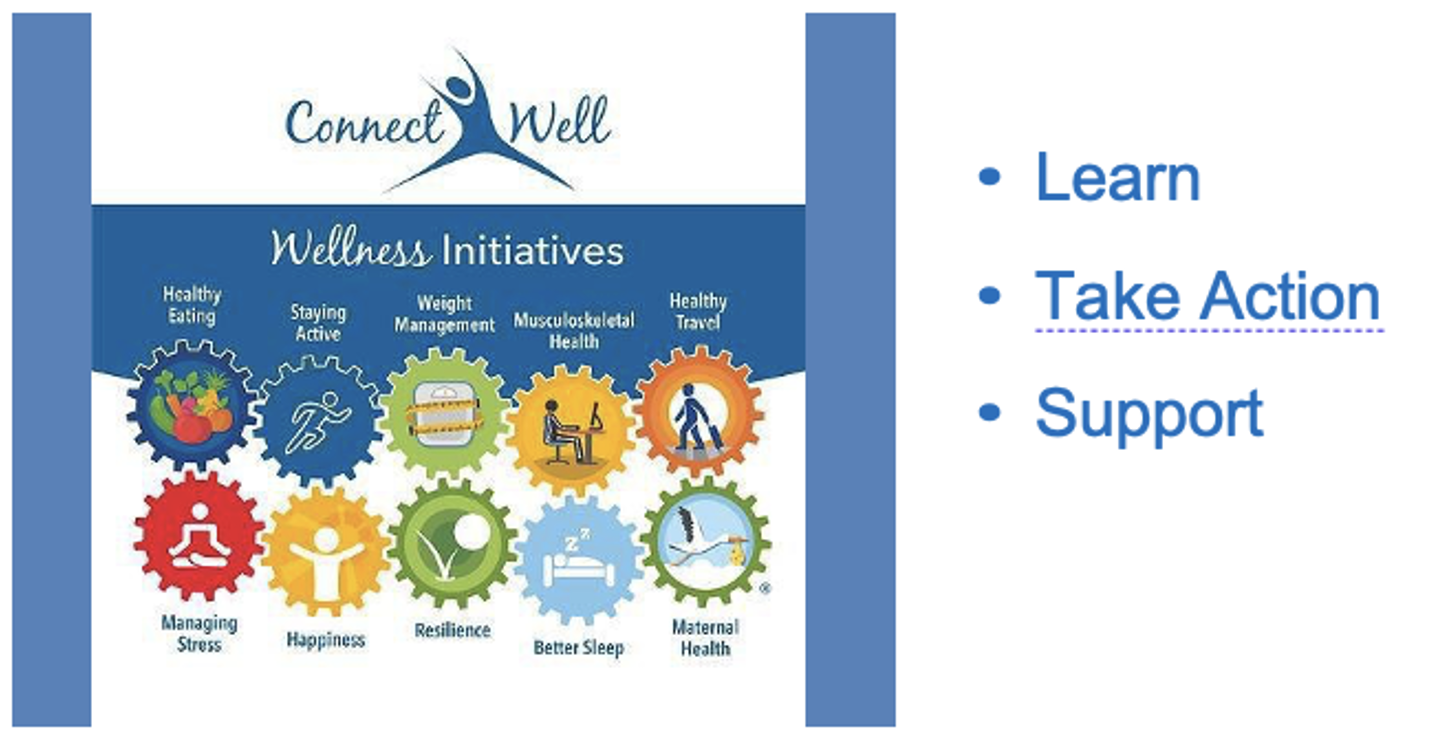 ConnectWell at the Library Supports the Adoption of Healthy Lifestyle Practices
ConnectWell at the Library Supports the Adoption of Healthy Lifestyle Practices
This Associated Press article “Libraries are offering free health and wellness classes across the US,” November 29, 2024, explains the various ways libraries are stepping in to support the public health of the community. The article states, “The public health programs leverage libraries’ reputation as sources of reliable information and their ability to reach people beyond formal health care settings. No money, insurance, language skills or ID required, no limits on age. All are welcome.” The ConnectWell Pilot adds another option for libraries to implement programs that are multi-week and support the adoption of healthy lifestyle habits. Given that 70% of preventable illness is due to an unhealthy lifestyle, ConnectWell’s Challenges can have a material impact on the health of the community.
ConnectWell has 18 Wellness Challenges that support people in the adoption of healthy lifestyle habits associated with: healthy eating, staying active, weight management, musculoskeletal health, healthy travel, managing stress, happiness, resilience, better sleep, and maternal health. Through the model (Learn, Take Action, Support), each ConnectWell Challenge is designed to help people learn about healthy habits, take action, and to be supported in their journey. These Challenges are 5-week programs that include training and a comprehensive set of materials designed for the library staff to successfully implement Challenges at their library site.
- Materials for Library Staff: Implementation guide, email template for announcing the challenge, weekly challenge communication template for use with participants, leader guide, virtual exhibit and passport to learning, Facebook group guide, and flyer for promoting the challenge to patrons
- Materials for Challenge Participants: Challenge sheet, participant resource listing with specific content (articles, videos, tools, recipes) supporting the adoption of healthy habits for each Challenge that resides on ConnectWell’s Health & Wellness Database
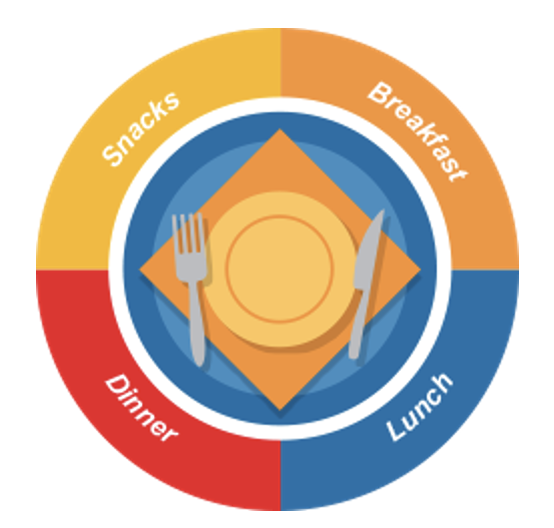 Description of the Pilot
Description of the Pilot
A thorough approach was taken in deploying this pilot using ConnectWell’s Balance Well Healthy Eating Challenge materials. Pilot activities included:
- Recruiting libraries to participate in the cohort — view Let’s Move in Libraries invitation to participate
- Training the librarians to be challenge facilitators by doing the challenge together as a working group for 5 weeks. Sessions were recorded and shared for those unable to attend in person.
- Deploying the challenges at each of the libraries.
- Providing ongoing support for libraries during their challenges through a private Facebook Group for the Challenge and email communication.
- Collecting participant surveys, and aggregating results.
It is important to note that deploying an impactful Wellness Challenge takes a considerable effort. Libraries need to put effort into recruiting participants that are prepared to commit to 5 consecutive weeks of programming. Facilitators must carve out the time to prepare for and implement the challenge each week and send out weekly communications to challenge participants to sustain engagement. There were 44 libraries that signed up for the training, 20 libraries participated in the training, and 12 libraries followed through to deploy the challenge at their library. Some of the attrition was due to the fires in Los Angeles, while some was due to lack of staffing or staff turnover. Taking those factors into consideration, over 1/3 of libraries that signed up followed through with implementing the 5-Week Balance Well Healthy Eating Challenge. These libraries and their staff gained experience delivering a program that is changing lifestyle habits for the better by eating meals and snacks made up of whole foods.
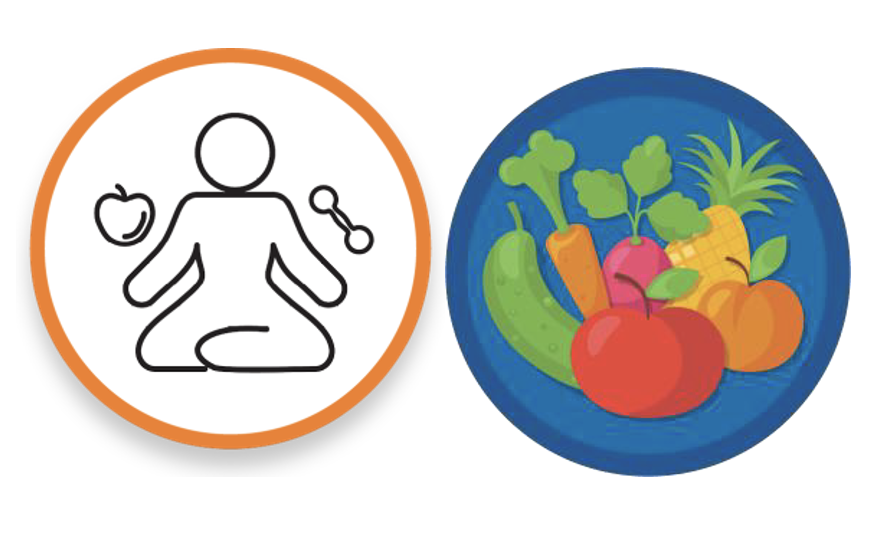 Teaching and Engaging Patrons in Healthy Lifestyle Practices
Teaching and Engaging Patrons in Healthy Lifestyle Practices
Week 1: Participants learned the basics of a healthy breakfast through the breakfast trio and learned why it is best to eat fruit rather than drink juice. During the week they were challenged to plan, shop, and prepare healthy breakfasts.
Week 2: Participants focused on using the 4-quadrant food-plate model to plan, shop, and prepare healthy lunches made up of whole foods. Healthy beverages were also discussed as sugar-sweetened beverages contribute significantly to the overconsumption of sugar in the US. During the week participants focused on eating healthy breakfasts and lunches.
Week 3: Participants layered on healthy dinners using the 4-quadrant food-plate model and took a deeper dive into reading food labels and selecting healthier food items when shopping. During the week they focused on eating healthy breakfasts, lunches and dinners.
Week 4: Participants focused on snacks without wrappers to consume snacks made up of whole foods. During the week they focused on eating healthy breakfasts, lunches, dinners and snacks.
Week 5: Participants came together to review their learnings and celebrate their success with a healthy potluck or recipe swap.
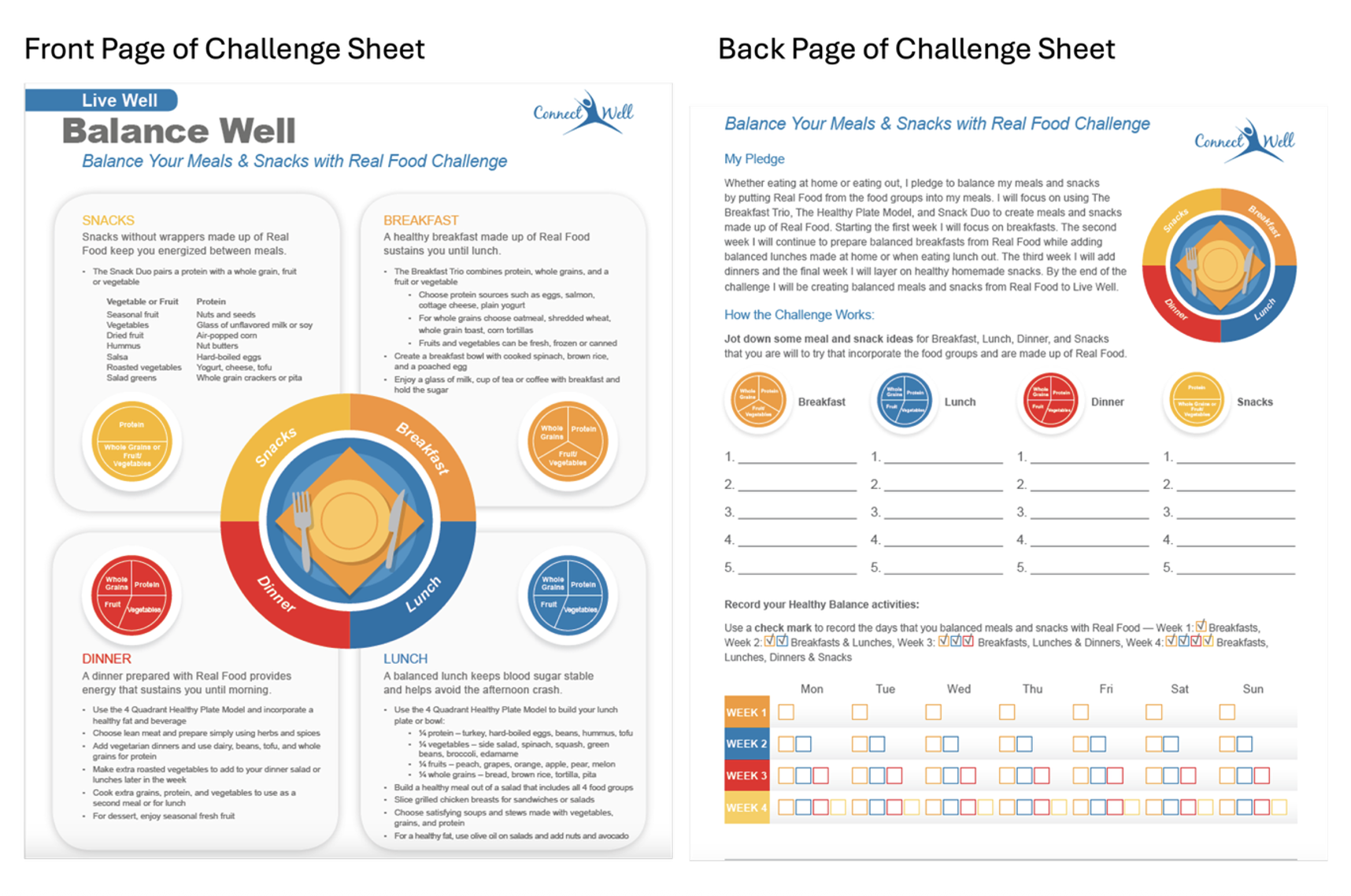 During the Challenge and for one month after the last library completed the Challenge, ConnectWell provided participants with access to ConnectWell’s Healthy Eating Collection from the Wellness Initiatives section of the database. This collection was developed with ConnectWell’s Scientific Advisory Board Experts, Dr. Robert Lustig and Luis Rodriguez, PhD who are thought leaders in addressing the drivers of metabolic syndrome, obesity, prediabetes, and diabetes. Each week there was a list with links to content to help participants learn about specific topics. Links to recipes from ConnectWell’s Healthy Recipe Collection were also listed for each week. This enabled participants to experiment with ConnectWell’s healthy recipes for breakfast, lunch, dinner, and snacks. ConnectWell’s Meal Planning and Shopping Guide Tools were provided to support these key practices that are fundamental to healthy eating. The facilitators used a subset of the content for each of 5 sessions listed in the leader guide to teach participants science-based practices for healthy eating.
During the Challenge and for one month after the last library completed the Challenge, ConnectWell provided participants with access to ConnectWell’s Healthy Eating Collection from the Wellness Initiatives section of the database. This collection was developed with ConnectWell’s Scientific Advisory Board Experts, Dr. Robert Lustig and Luis Rodriguez, PhD who are thought leaders in addressing the drivers of metabolic syndrome, obesity, prediabetes, and diabetes. Each week there was a list with links to content to help participants learn about specific topics. Links to recipes from ConnectWell’s Healthy Recipe Collection were also listed for each week. This enabled participants to experiment with ConnectWell’s healthy recipes for breakfast, lunch, dinner, and snacks. ConnectWell’s Meal Planning and Shopping Guide Tools were provided to support these key practices that are fundamental to healthy eating. The facilitators used a subset of the content for each of 5 sessions listed in the leader guide to teach participants science-based practices for healthy eating.
Participants used the Challenge Sheet to make healthy changes in their lifestyle and track their progress. Each participant determined their personal goals and objectives for the Balance Well Healthy Eating Challenge. The sessions, resources, and community support provided guidance, inspiration, and encouragement to make healthy changes.
Facilitator Survey Results and Testimonials
After the Library Facilitator Cohort completed their training by participating in the 5-Week Balance Well Healthy Challenge together, a 9-question survey was administered. Of the 20 libraries that participated in the Cohort, 15 people responded to the survey, and 12 followed through with implementing the challenge at their library. Survey results are displayed below and percentages were rounded to whole numbers.
- How would you rate the quality of the Kickoff Meeting to provide an overview of the Challenge?
13% Excellent; 67% Very Good; 20% Good; 0% Fair; 0% Poor
- How would you rate the 5 Weekly Challenge Meetings held January 6-February 3 to help you understand the role of the facilitator and how to use the resources provided in the Dropbox folder?
7% Excellent; 60% Very Good; 27% Good; 0% Fair; 0% Poor; 7% Did not Attend or Listen to Recordings
- How would you rate the quality of the resources made available to you in the Dropbox folder to support your efforts to implement the Challenge in your library?
33% Excellent; 40% Very Good; 20% Good; 0% Fair; 0% Poor; 7% Did not Review Resources
- How would you rate the email communications throughout the program to keep you updated on the Challenge process as a facilitator.
33% Excellent; 47% Very Good; 7% Good; 7% Fair; 0% Poor; 7% Did not review email communications
- How would you rate the email communications throughout the program to keep you updated on Challenge activities as a participant.
27% Excellent; 40% Very Good; 20% Good; 7% Fair; 0% Poor; 7% Did not review email communications
- How would you rate the 5 Weekly Challenge Meetings as a participant in learning the practices for Balancing your Meals and Snacks with Whole Foods?
14% Excellent; 43% Very Good; 36% Good; 0% Fair; 0% Poor; 7% Did not attend Challenge Meetings or listen to Recordings
- Did participating in the Challenge increase your knowledge of healthy eating and nutrition?
53% Significantly; 27% Somewhat; 13% not much; 0% Not at all; 7% Did not fully participate
- Now that have you completed the Program, how well did we prepare you to organize, recruit, and facilitate the Challenge at your library.
13% Strongly prepared; 27% Well prepared; 47% Prepared; 0% Do not feel prepared; 13% Did not fully participate and as a result I am not prepared
- How likely are you to recommend ConnectWell as a resource for your library and to other libraries.
33% Very likely; 47% Likely; 13% Neither likely or unlikely; 7% Unlikely
Facilitator Testimonials
“I found this experience to be interesting, informative, and effective. I thoroughly enjoyed getting to demo the Challenge beforehand. It didn’t take an excessive amount of time and did not feel laborsome in the least. The content itself is amazing, we had real life examples and recipes. Everything was truly beneficial. We were able to see library websites that implement the ConnectWell Program and that visual immediately convinced me to go to my Director and encourage her to find a place in the budget for us to offer this.” Rural Library in Tennessee
“I felt prepared to facilitate the Challenge at my library. I’m not a nutritionist or health care professional, but felt I had enough information about the program to share with my community.” Rural Library in New Hampshire
“This program is a great refresher course, plus I’m learning new things. Especially about oils and cooking temps.” Rural Library in Iowa
“The community that was formed during these sessions were so amazing to see. I just jumped into Adult Services after a whole lifetime of youth related jobs (from teaching, to media specialist, and youth supervisor). It was awesome to see the adults engaged and excited about something, too. It was nice to co-teach this with my Manager. She gathered the information she wanted, put together the PowerPoint from the templates and presented. I gathered items I wanted to include in the PowerPoints, shared information from my personal experience and took notes to address items discussed in class, got the donations and wrote the emails. It was easy this way. At the end of class we got some great feedback and emails from the participants. We even got a small gift from one – glass containers for snacks. This was a great experience. Thanks for picking us!” Suburban Library in Arizona
“We talked dinner last week, and a lot about portion control. My group has been really diving in! And they don’t want to miss, so having the evening and morning groups has allowed them to switch when necessary. Remember the man who said, “you’re going to ruin my life”? He’s probably the most dedicated! He was in the library this morning telling me about what he ate over the weekend. We tried out the Mediterranean orzo and vegetable recipe. Delicious! This has been very rewarding. In my 16 years here, this is the first time I’ve run a long-term program like this. It’s been good to see people stick with it!” Rural Library in Iowa
Library Challenge Activities
Below is a collage of some of the recruiting flyers libraries used to encourage patrons to sign-up for the challenge.
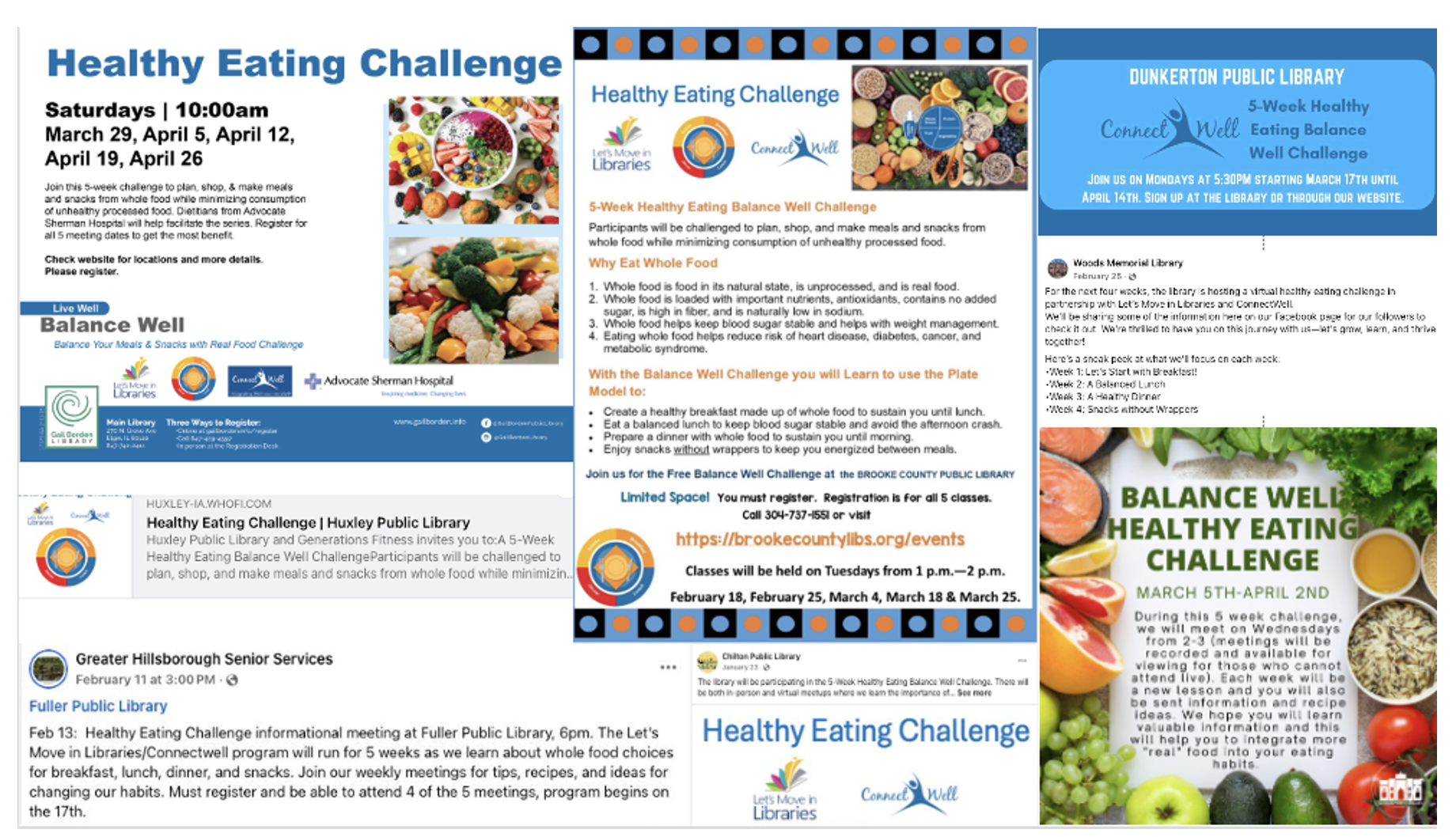
Groups ranged in size from 4 to 25 participants. During the challenge each library implemented the challenge uniquely for their participants including:
- Virtual Meetings, In-Person, Hybrid (in-person & virtual)
- Multiple Sessions Offered Weekly (morning and evening and on different days of the week)
- Recording of Sessions
- Partner with community organizations: Parks & Recreation, Local Hospital, Dietitian
- Incorporating food into the sessions
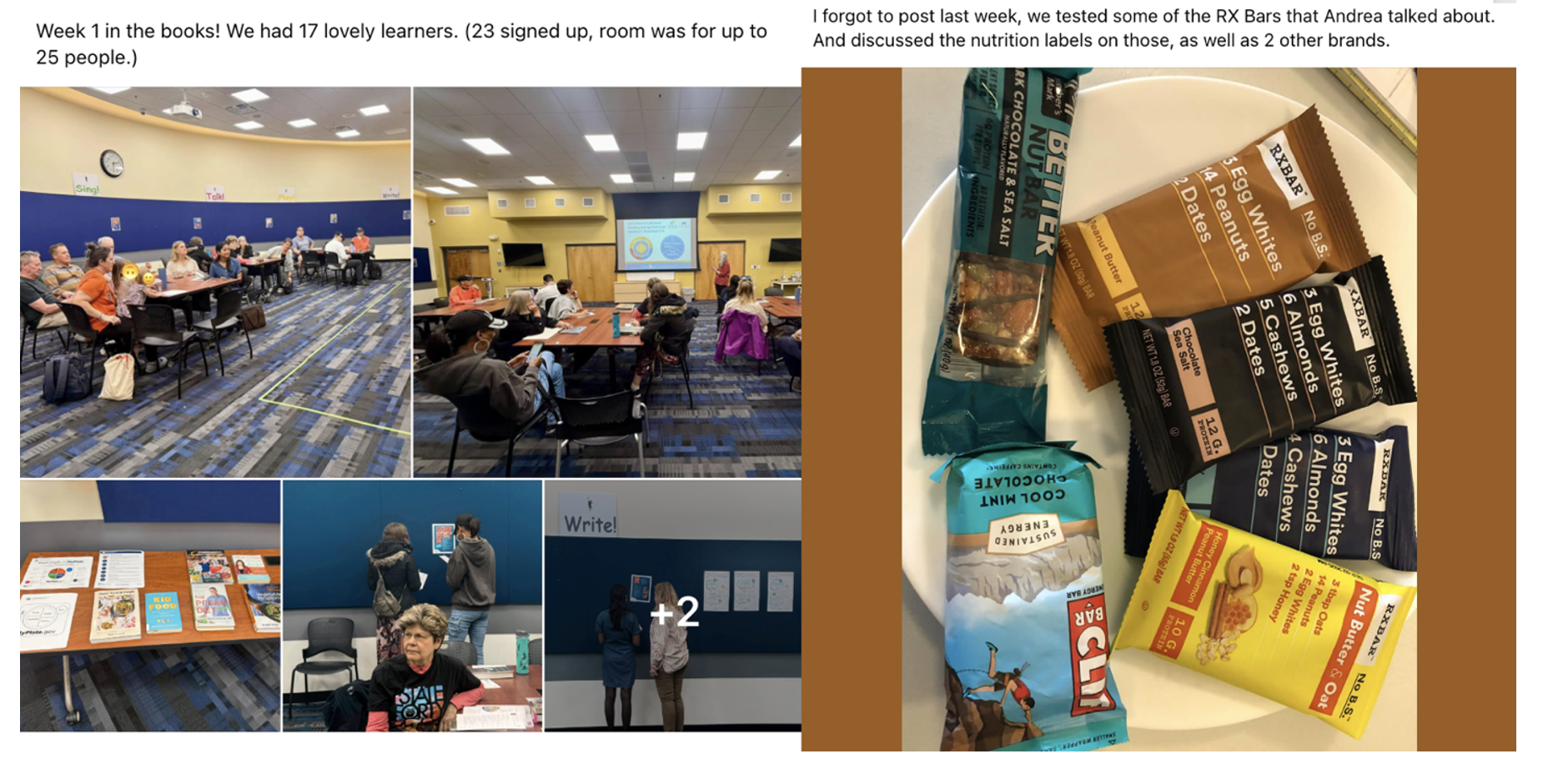

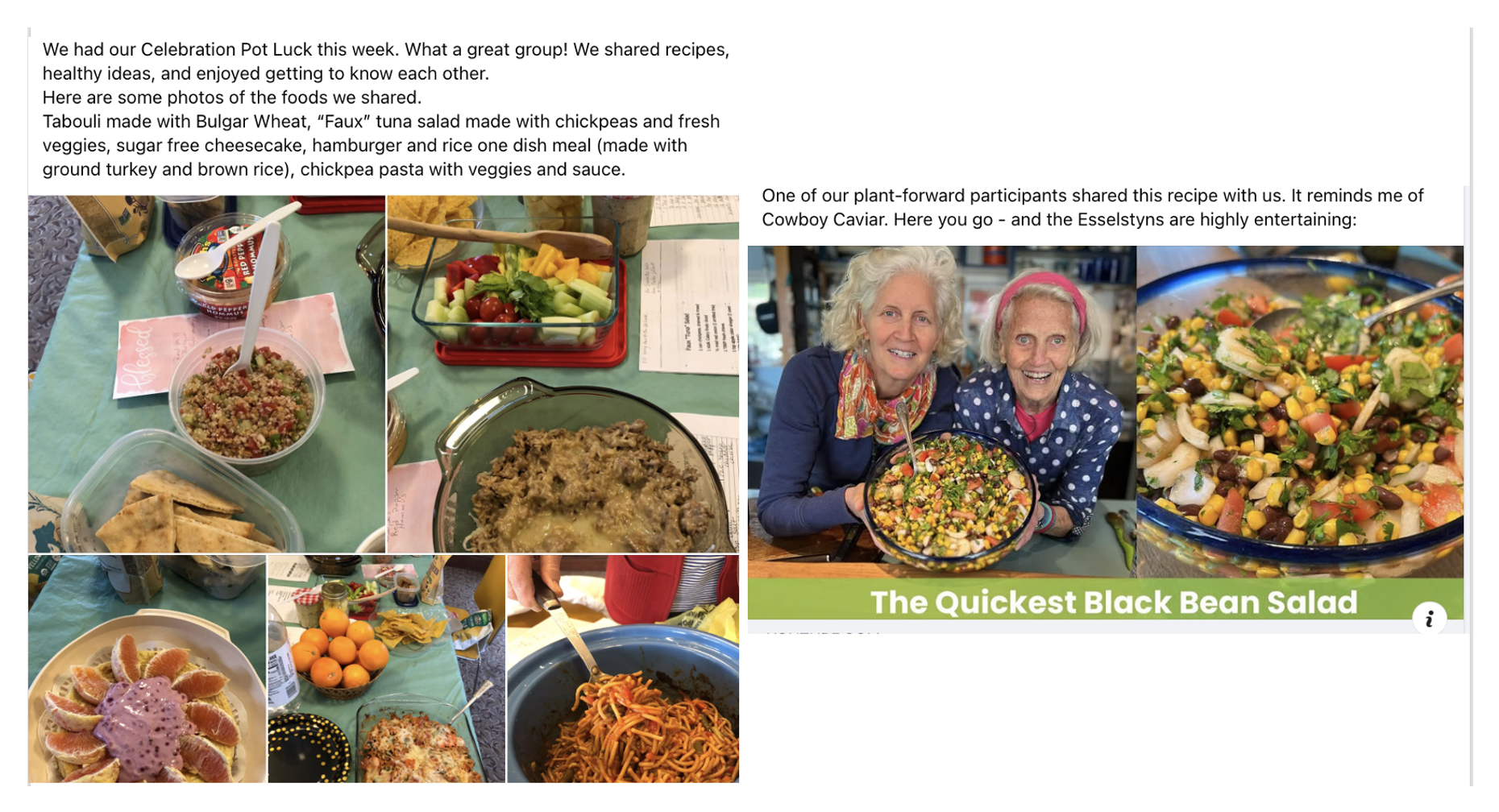
Diving into the Data
From the time of the Kick-off December 9, 2024 through the end of the Challenge period July 31, 2025, there were 7,256 clicks on the participant resources listing that connected facilitators and participants to ConnectWell’s database. This data validates that ConnectWell’s accompanying programs deliver high utilization rates when combined with the related digital resources. A wide range of content was accessed in the form of articles, tools, videos and recipes. The ConnectWell Wellness Initiatives include links to related articles at the bottom of each content piece which enabled people to expand their learning beyond the articles listed in the curriculum.
Diving into the data is very exciting and demonstrates the type of learning that participants engaged in throughout the challenge. Tools such as the Weekly Meal Planning, Shopping Guide, and Activity for Creating a Healthy Food Environment were accessed 210, 232, and 186 times respectively. This demonstrates participants were using these tools as part of the challenge to implement practices that foster healthy eating. The articles Decoding Nutrition Facts on Food Labels and Selecting Healthy Packaged Food were accessed 164 and 123 times respectively. This demonstrates that participants were spending time learning about how to read food labels to make informed food choices. The articles The Components of Healthy Breakfast, Lunches, Dinners, and Snacks are at the heart of healthy eating and these were accessed 896 times collectively. The UCTV videos which are sourced from University of California, provided participants with the opportunity to learn direct from experts. Popular video topics included: Fiber, Portion Sizes, Sugar, Refined Grains, Reversal of Disease, Sodium, Fats, Omega-3 and more. It was exciting to see people access so many recipes and enjoy exploring new combinations of whole foods.
Below is a breakdown of content accessed during the pilot period. Take a dive into the data to explore the range of titles that participants viewed to learn about the healthy eating practices and how to implement them into daily living.
5007 clicks on these Wellness Initiative Titles listed in alphabetical order (number of clicks per title):
- Activity for Creating a Healthy Food Environment (186)
- Alcohol (85)
- Back to School Nutrition: Healthy Homemade Lunches (155)
- Beverage Guidelines for Children 5 and Under (42)
- Build Your Plate With Whole Foods (359)
- Building a Healthy Lunch To-Go (114)
- Choosing Healthy Fats and Minimizing Unhealthy Fats (108)
- Coffee and Caffeine (113)
- Cooking with Healthy Fats (101
- Decoding Nutrition Facts on Food Labels (164)
- Eating Together Encourages Healthy Eating (6)
- Eating with the Seasons: Winter, Spring, Summer, Fall (45)
- Finding of Diet Soda Studies (136)
- Give a Gift of Healthy Eating for Any Occasion (26)
- Guide to Selecting Fish (96)
- Healthy Drinking, Eating and Portions at Parties (6)
- Healthy Eating, Drinking and Portions at a Friend’s House (6)
- Healthy Eating, Drinking and Portions At Restaurants (31)
- Healthy Portion Sizes (59)
- Hydrate with Healthy Beverages (109)
- Organizing Healthy Potlucks (23)
- Overview of Nutrition: Consumption of Healthy Foods and Beverages (80)
- Pacing Your Eating (6)
- Portion Size and Weight Management (8)
- Portion Strategies for Eating at Home (6)
- Protein (119)
- Protein Recommendations (101)
- Reduce Eating Opportunities with Non-food Rewards (3)
- Salt and Sodium (24)
- Selecting Healthy Packaged Food (123)
- Selection Tips for Poultry and Eggs (46)
- Selection Tips for Produce: Organic and Conventional (78)
- Shopping Guide (232)
- Shopping in the Bulk Bin Section (58)
- Shopping Locally: Farmers’ Markets and Community Supported Agriculture (57)
- Shopping Tips for Healthy Ingredients (128)
- Soda and Sugar-Sweetened Beverages (65)
- Sports Beverages (48)
- Sugar, The Bitter Truth (109)
- The Components of Healthy Breakfasts (349)
- The Components of Healthy Dinners (174)
- The Components of Healthy Lunches (192)
- The Components of Healthy Snacks (181)
- The Truth About Juice (151)
- USDA Guidelines for Organic Meat and Dairy (23)
- Using Herbs and Spices (73)
- Using SNAP and WIC Benefits to Support Your Nutrition (51)
- Vegetables and Fruit (88)
- Water, Healthy Hydration, and Dehydration (30)
- Weekly Meal Planning (210)
- Whole Grains (195)
- Why Eat Organic? (29)
474 clicks on these Videos titles listed in alphabetical order (number of clicks per title):
- “Added Fiber” Foods are Fiber Deficient (17)
- A Serving Size of Meat versus What You Get at a Steakhouse (34)
- Are you Getting Enough Fiber? (67)
- Brightly Colored Foods Speak to our Genes (27)
- Can Natural Foods Compete with the Modern Food Environment? (8)
- Cutting Back on Inflammatory Fats (17)
- Dangers of a High Sodium Diet (29)
- Omega-3 in Seafood: Weekly Suggestions (9)
- Plant Sources of Omega-3 (32)
- Poultry Fat Content: It Depends on the Cut (6)
- Red Meat, Disease and Inflammation (6)
- Responsibility of the Food Industry (28)
- Reversal of Disease using a Whole-Food, Plant-Based Diet (37)
- Taking On Big Soda (and Winning) (9)
- Taste Expectations: The Power of Words (28)
- Tea or Coffee? (9)
- The American Diet Gone Bad: Refined Grains (42)
- The Skinny on Obesity (Ep. 2): Sickeningly Sweet (10)
- The Skinny on Obesity (Ep. 4): Sugar — A Sweet Addiction (5)
- Watch Your Portion Sizes …of Protein (46)
- What is a Serving of Grain? (8)
1775 clicks on these Recipe titles listed in alphabetical order (number of clicks per title):
- Baked Acorn Squash with Curried Rice (33)
- Basmati Rice, Chickpeas & Toasted Almonds (30)
- Big-Batch Lentil-Bean Soup (98)
- Buckwheat & Currant Pancakes (40)
- Chicken & Roasted Root Vegetables (42)
- Chimichurri Sauce (32)
- Creamy Roasted Garlic Dressing (30)
- Creamy Two-Mushroom Soup (113)
- Date & Walnut Bread (48)
- Frittata with Asparagus & Potatoes (145)
- Green Beans with Fresh Tomatoes & Basil (34)
- Guacamole (26)
- High Protein Corn & Quinoa Vegetarian Salad (105)
- Jasmine Rice Salad (65)
- Lentils with Fennel & Tomato (47)
- Mediterranean Orzo (115)
- Orange-Balsamic Dressing & Marinade (51)
- Orange-Mint Carrots (48)
- Oven-Roasted Salmon Fillets (124)
- Quinoa Pilaf with Cherries & Pecans (34)
- Roasted Pear Salad with Blue Cheese Dressing (38)
- Roasted Shiitake & Cheese Quesadillas (43)
- Spicy Pear & Pepper Salsa (29)
- Sunshine Bread (91)
- Tabbouleh (44)
- Toasted Wheat & Flaxseed Pancakes (133)
- Traditional Hummus (28)
- Wild Rice Pilaf with Pumpkin Seeds (29)
- Yogurt Cheese (80)
Participant Survey Results
We received surveys from 55 participants which represented approximately 60% of total participants. Here is a summary of the survey results when taking into account the ConnectWell Challenge Model (Learn, Take Action, Support):
Learn: Participants gave high ratings to the quality of the challenge materials, database content, weekly meetings, and communications, and increased their nutrition knowledge.
Take Action: Participants took action by following the challenge and changing or intending to change their eating habits across 19 metrics, and 91% plan to continue with the eating practices they learned in the challenge. The chart below paints a picture of how challenge participants were changing or intending to change their eating habits. Initiating and sustaining healthy eating practices are core to preventing and reversing food-related illnesses (metabolic syndrome, prediabetes, obesity, diabetes) that impact the majority of Americans.
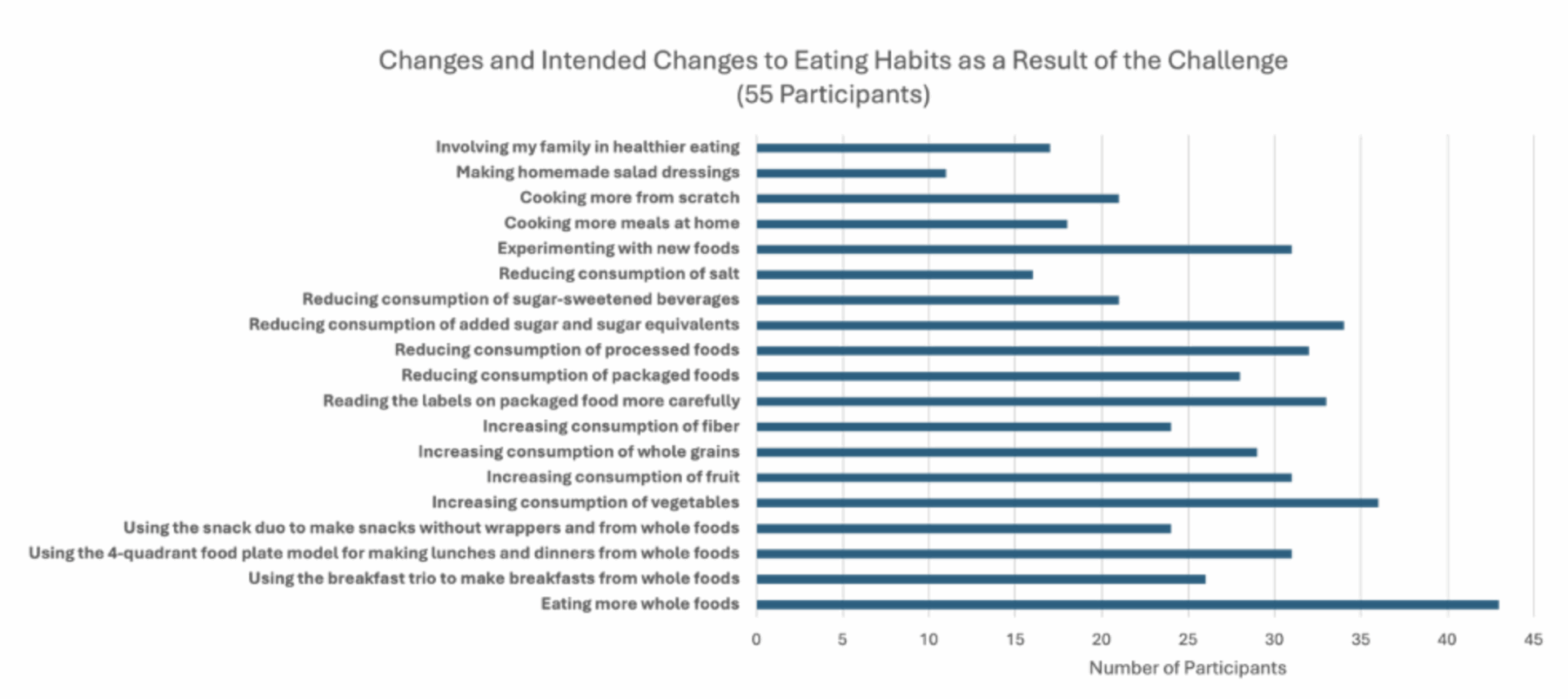
Support: 100% of participants had a positive Challenge experience and felt their library was effective in delivering the Challenge, and 93% are interested in doing another Challenge.
Survey results solidly support the ConnectWell Challenge Model and provide strong rationale for libraries to invest the time and resources in subscribing to and delivering these types of programs that support public health.
==
See the detailed participant survey results below.
- How would you rate your overall experience with the “Balance Well” Challenge?
51% Excellent; 34% Very Good; 13% Good; 0% Fair; 0% Poor; 2% Did not Attend the Challenge
- Rate the quality of the “Balance Well” Challenge content (Virtual Exhibit & Passport to Learning; Participant Resources including: articles, videos, tools; Challenge Sheet; Weekly Meal Planning and Shopping Guides).
48% Excellent; 38% Very Good; 11% Good; 2% Fair; 0% Poor; 2% Did not Review Resources
- Did you feel the Challenge was engaging and easy to follow?
61% Yes, absolutely; 32% Mostly; 7% Somewhat; 0% Not really; 0% Not at all
- Rate the quality of the Weekly Challenge Meetings in learning the practices for Balancing your Meals and Snacks with Whole Foods.
47% Excellent; 38% Very Good; 11% Good; 0% Fair; 0% Poor; 4% Did not attend Weekly Challenge Meetings
- Rate the email communications throughout the program to keep you updated on Challenge activities.
55% Excellent; 18% Very Good; 16% Good; 4% Fair; 4% Poor; 4% Did not read email communications
- Did participating in the Challenge increase your knowledge of healthy eating and nutrition?
54% Yes, significantly; 41% Yes, somewhat; 5% Yes, a bit; 0% Not at all; 0% Did not fully participate
- Check all the changes you have made or intend to make to your eating habits as a result of this Challenge. (Check all that apply) See chart above.
- How likely are you to continue with the healthy eating practices that you learned in the Challenge?
61% Very Likely; 30% Likely; 9% Neither likely or unlikely; 0% Unlikely
- Now that you have completed the Challenge, would you be interested in doing another Challenge?
49% Very Likely; 44% Likely; 7% Neither likely or unlikely; 0% Unlikely - Rate your library’s overall effectiveness in delivering this Challenge program. Consider these factors: making you aware of the Challenge, organizing the Challenge, and delivering a strong program.
66% Excellent; 21% Very Good; 13% Good; 0% Fair; 0% Poor
Learn More:
About ConnectWell: www.connectwell.health
ConnectWell is a leading-edge provider of science-based digital health and wellness content and programs that are designed for a consumer audience to engage people in their total health and well-being. ConnectWell’s content suite is uniquely deployed through innovative programs and digital applications for creative content delivery that activates end users. ConnectWell’s digital resource and program elements form a robust offering that scales health literacy and puts healthy lifestyle practices into action. Andrea Bloom is the Founder of ConnectWell.
About Let’s Move in Libraries: www.LetsMoveInLibraries.org
Let’s Move in Libraries was founded in 2016. It is directed by Dr. Noah Lenstra, MLS, Assistant Professor of Library and Information Science at the University of North Carolina at Greensboro. This international initiative to support healthy living through public libraries has over 5,000 public librarians and public library supporters engaged through social media, the project website, and its monthly newsletter.
